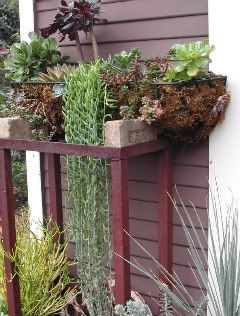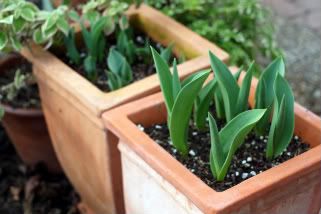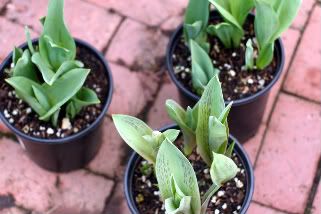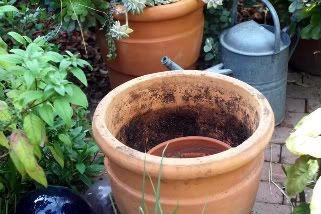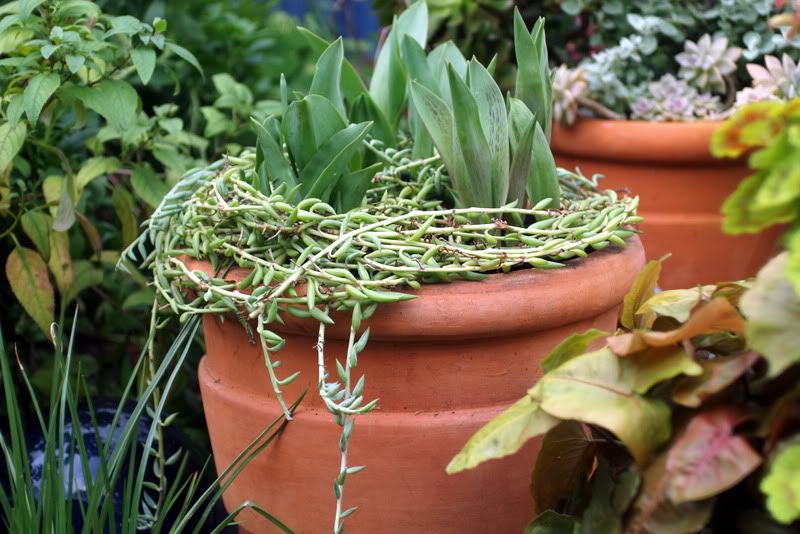Some backstory, which begins improbably enough with tulips. The two plants would seem to have nothing whatsoever in common,
but that’s the joy of backyard Frankensteinian horticultural experiments, where you’re mad scientist in chief. And if you get up early
enough, there’ll be no witnesses, one of the best incentives for rising early next to strong black coffee.
Fishhook senecio, S. radicans, is commonly used to dramatically spill out of succulent container plantings,
like this one I made in a hay trough a few years ago:
It grows so fast, at the speed of knots, spilling and draping, puddling and pooling, that I’ve come to grow it less and less.
A couple pots are kept, shoved into unloved spaces now. Its vigor has caused it to lose favor with me,
but I keep it because it oozes potential.
Now the tulips. In zone 10, where mid-winter skiers drive an hour outside of Los Angeles to zip downhill in artificial snow,
tulips also need some fakery. The cold they need to bloom won’t be supplied by outdoor temps, so they are placed in
the vegetable bin of a refrigerator after purchase in fall, then potted up in late November, a necessary span of at least
six weeks for good results. Bad results look like the tulips are hunkered down in response to an air raid siren, just peeking over
the tops of leaves, never achieving any stem length at all.
Dark purple and apricot blend tulips were planted in these urns, but there were leftover bulbs, planted in hideous black plastic gallon pots:
With the backstory handled, now we’re regaining some momentum to this tale.
The tulips have been moved into the sun, buds are forming, stems
elongating. So far, so good. But there’s still those hideous black pots.
I assumed the black pots of tulips in bloom would be cleverly hidden in the garden amidst
blowsy spring annuals, but growth in the garden is not tall enough yet for such
chicanery, and the tulips are rapidly rushing into flower. A large pot is now what’s
needed to serve as a cache pot, and there happens to be just such a pot standing idly by.
with another pot nested inside for a platform for the tulip pots to
stand on. Expect lots of rummaging through old pots to make this work.
Once the platform of nested pots is adjusted, on go the tulip pots.
Now it’s apparent the whole arrangement is simply more of the same hideous because
the black pots cannot be concealed short of stuffing the spaces with
moss, a technique best reserved for the sterility of business office foyers (and I
don’t have any moss, darn it).
A filler is needed, but what?
It is at just such a moment that the gardener methodically walks the length and breadth of her
garden, taking new inventory of the familiar with laser-like focus, possibly muttering softly to
herself. A plectranthus is temporarily considered but rejected for not enough leaf.
Mid-winter there’s absolutely nothing that will do — but wait, what about the fishhook?
That’s the answer!
The pot is grabbed from its neglected status on a side porch flanking the driveway
and carried into the back garden, 5 feet of trailing fishhook bringing up the rear.
Some careful maneuvering onto a couple bricks for the new platform, some wrapping and weaving,
and the black plastic pots are hidden.
And after that buildup, I know the next photo might seem a tad anti-climactic:
Possibly slightly better than hideous. But I was newly struck by the amazing potential of
S. radicans. With so much interest in plant material for roofing and even siding of green buildings,
for zone 10 I submit the fishhook senecio for consideration. Because it is pliable and will root at leaf nodes,
the possibilities seem endless. I’ll probably take this experiment with tulips apart, but what about
wrapping a moss orb round and round, where it can root and trail at will? Or “curtains” of fishhook
senecio for a faux window on a fence? No doubt more early morning experiments are ahead this summer.

